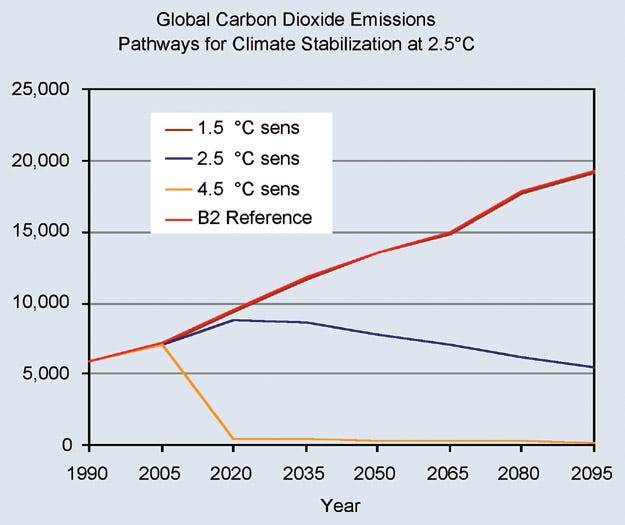Links for Friday, February 2: Climate Sensitivity and a Scheduling Note
Trouble ahead, and soon. Climate sensitivity — a measure of how strongly our climate reacts to increased CO2 — is likely to be far greater than a hopeful world believes.

Today I offer an abbreviated Links post. I’m taking a short break to visit friends, back the week after next. In the meantime, I hope everyone has a delightful, well, early February.
Links
Despite this post’s abbreviation in length, it’s not abbreviated in importance. Sabine Hossenfelter, a scientist and video producer, has made a YouTube (see below) that discusses something long-time readers of this site should be familiar with — James Hansen’s latest paper, “Global Warming in the Pipeline.”
My earlier comments on this paper can be found here:
In “A New Climate Frontier” I wrote this regarding the concept of “climate sensitivity”:
About equilibrium climate sensitivity, Hansen writes:
The recent revelation (Global warming in the pipeline) from paleoclimate data that equilibrium climate sensitivity (ECS) is 4.8°C ± 1.2°C for 2×CO2 implies that clouds provide a strong amplifying climate feedback, as, without cloud feedbacks, ECS would be ~2.5-3°C for 2×CO2.
This requires a little explaining. Imagine throwing a basketball against a wall from six feet away with a well-defined force. ECS is, in that metaphor, a measure of how far back the ball bounces, all other things being equal.
If sensitivity is low (a less “bouncy” ball), the response will be small, and the ball will hit the ground maybe two feet from the wall. But if sensitivity is high (a very bouncy ball), it may go flying back, landing maybe five feet from the wall, or eight, or ten.
Equilibrium climate sensitivity says, if you suddenly double atmospheric CO2 (the "well-defined force”), at what higher temperature will the climate system stabilize and reach equilibrium (the “bounce”)?
So climate sensitivity is a measure of the responsiveness of the climate to changes in atmospheric CO2 — both how much it will respond and how fast.
Listen to the video below starting at 2:58 to jump to that discussion (I’ve cued it up at that point), or listen starting from the beginning to hear her good lead-up, which includes a discussion of the El Niño effect on our current weather.
At 4:15 she talks about what was previously assumed about climate sensitivity (ECS). Her range — ECS of 2.0–4.5 — is usually averaged out to ECS of 3.0, and if you read the literature, you’ve seen that number used comfortably for decades. It even has a name, Charney sensitivity. Here’s one reference:
In 1979, the Charney Report from the US National Academy of Sciences suggested that ECS was likely somewhere between 1.5C and 4.5C per doubling of CO2. Nearly 40 years later, the best estimate of sensitivity is largely the same.
Everything you’re read or heard about how much time we have before the climate crisis strikes us, is based on those assumptions. Goals of “reducing emissions by half before 2030” or “net zero emissions by 2050” — today’s official U.S. climate posture — assumes a low, and presumed safe-for-now, ECS. (Low ECS also allows the donor class more time to monetize their carbon assets, but let’s leave that aside for now.)
At 5:09 she discusses the “hot models” problem, when several models started showing ECS of greater than 5.0. “If these models are correct, it means that the climate situation would go to hell twice as fast as we expected.” A long discussion of these models follows.
The information about modeling clouds as greenhouse gases (you read that right; they are) comes at 7:13.
At 11:22 she begins discussing Hansen’s new paper; it’s here the discoveries begins. Hansen’s paleoclimate data agrees with the “hot models.” Again (my emphasis):
The recent revelation (Global warming in the pipeline) from paleoclimate data [is] that equilibrium climate sensitivity (ECS) is 4.8°C ± 1.2°C for 2×CO2 [.]
Hossenfelter’s bottom line: “Climate sensitivity above 5°C can’t be easily dismissed.”
That should be yours as well. Look at the orange line in chart at the top again. If climate sensitivity is as high as 4.5°C, to meet a target of +2.5°C “global CO2 emissions would have to go to zero within 15 years.”
Counting from 2004, that’s … yesterday.
Music
And your musical treat for today, here’s the first jazz protest song, a beauty by Les McCann and Eddie Harris, “Real Compared to What”
The President, he's got his war
Folks don't know just what it's for
No one gives us rhyme or reason
Have one doubt, they call it treason
We're chicken feathers all without one gut
God damn it
Tryin' to make it real compared to what?Have one doubt, they call it treason. Timely, no?
See you after the break.




That is one very frightening video because Sabine Hossenfelter is a very accomplished physicist who has a deep understanding of the implication of those numbers.
I only have a B.S. in physics, but constantly meet with frustration as many of my fellow beings do not appreciate how vast an increase in energy gets connoted by a 1 degree Celcius rise in average atmospheric temperature.
Too, most are not familiar with the wet bulb temperature limit that when broken means death.
Our finite planet is going to present us with many limits in our lifetimes and those of our descendants, but let me assure you, our descendants will very much prefer that we take to walking for transportation.
Just a quick note to confess that I skipped to the bottom to see the musical section!
An amazing fact about "Real Compared to What" is that all the performers in the song attended the music festival with different acts. They had not performed together before. Les McCann got seriously stoned to calm his nerves before coming on stage.
Thanks for this wonderful pick and yes, the lyrics are timeless, the despots that rule us would not have it any other way.